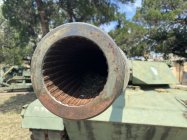I have lined up with conventional thinking, always using stainless barrels for matches. Target rifles get wet from time to time after all, and they do cost more, so they must be better.
Lately though, I have contemplated the proportion of elements that make stainless steel more resistant to rust. I have looked at my collection of buttons, stubs, and throats and threads. Though we are kind of conditioned to consider stainless “tougher,” things like smearing, galling and how the softer metallic elements are also the rust resistant ones that may be used, come to mind.
Then, when I consider every cost-is-no-object barrel, whether to endure sea spray and mist, scorching heat, or, closer to our purposes, military procured precision fire small arms, always having one additional digit in its price, I just don’t see stainless steel being chosen.
Surely, at these highest, most demanding levels of uses, stainless is not too expensive to select. An F-22 ($180M) has a rotary cannon with rifled barrels, to engage another $100M target. While I want to think my shots into the berm matter (2 dollars), those shots actually do. So I guess my question is why haven’t entities like ATK, GE, FNH, SACO Defense and all, come around?
Assuming a willingness to coat, (at least with oil) should we try CM? Could it last less long?

Lately though, I have contemplated the proportion of elements that make stainless steel more resistant to rust. I have looked at my collection of buttons, stubs, and throats and threads. Though we are kind of conditioned to consider stainless “tougher,” things like smearing, galling and how the softer metallic elements are also the rust resistant ones that may be used, come to mind.
Then, when I consider every cost-is-no-object barrel, whether to endure sea spray and mist, scorching heat, or, closer to our purposes, military procured precision fire small arms, always having one additional digit in its price, I just don’t see stainless steel being chosen.
Surely, at these highest, most demanding levels of uses, stainless is not too expensive to select. An F-22 ($180M) has a rotary cannon with rifled barrels, to engage another $100M target. While I want to think my shots into the berm matter (2 dollars), those shots actually do. So I guess my question is why haven’t entities like ATK, GE, FNH, SACO Defense and all, come around?
Assuming a willingness to coat, (at least with oil) should we try CM? Could it last less long?

Last edited:










